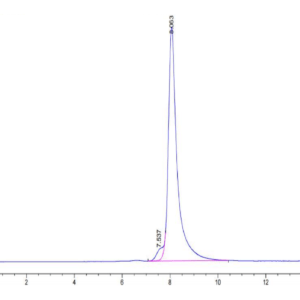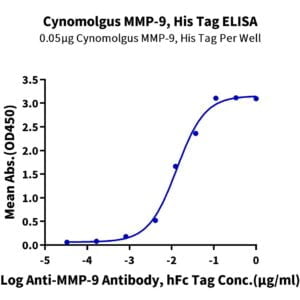| Weight | 1 lbs |
|---|---|
| Dimensions | 9 × 5 × 2 in |
| accession | P04054 |
| express system | HEK293 |
| product tag | C-His |
| purity | > 95% as determined by Tris-Bis PAGE;> 95% as determined by HPLC |
| background | Phospholipase A2 (PLA2) plays crucial roles in diverse cellular responses, including phospholipid digestion and metabolism, host defense and signal transduction. PLA2 provides precursors for generation of eicosanoids, such as prostaglandins (PGs) and leukotrienes (LTs), when the cleaved fatty acid is arachidonic acid, platelet-activating factor (PAF) when the sn-1 position of the phosphatidylcholine contains an alkyl ether linkage and some bioactive lysophospholipids, such as lysophosphatidic acid (lysoPA). |
| molecular weight | The protein has a predicted MW of 15.23 kDa. Due to glycosylation, the protein migrates to 18-23 kDa based on Tris-Bis PAGE result. |
| available size | 100 µg, 500 µg |
| endotoxin | Less than 1EU per μg by the LAL method. |
Human PLA2G1B Protein 2848
$315.00 – $1,050.00
Summary
- Expression: HEK293
- Pure: Yes (HPLC)
- Amino Acid Range: Ala23-Ser148
Human PLA2G1B Protein 2848
| protein |
|---|
| Size and concentration 100, 500µg and lyophilized |
| Form Lyophilized |
| Storage Instructions Valid for 12 months from date of receipt when stored at -80°C. Recommend to aliquot the protein into smaller quantities for optimal storage. Please minimize freeze-thaw cycles. |
| Storage buffer Shipped at ambient temperature. |
| Purity > 95% as determined by Tris-Bis PAGE |
| target relevance |
|---|
| Phospholipase A2 (PLA2) plays crucial roles in diverse cellular responses, including phospholipid digestion and metabolism, host defense and signal transduction. PLA2 provides precursors for generation of eicosanoids, such as prostaglandins (PGs) and leukotrienes (LTs), when the cleaved fatty acid is arachidonic acid, platelet-activating factor (PAF) when the sn-1 position of the phosphatidylcholine contains an alkyl ether linkage and some bioactive lysophospholipids, such as lysophosphatidic acid (lysoPA). |
| Protein names Phospholipase A2 (EC 3.1.1.4) (Group IB phospholipase A2) (Phosphatidylcholine 2-acylhydrolase 1B) |
| Gene names PLA2G1B,PLA2G1B PLA2 PLA2A PPLA2 |
| Protein family Phospholipase A2 family |
| Mass 9606Da |
| Function Secretory calcium-dependent phospholipase A2 that primarily targets dietary phospholipids in the intestinal tract (PubMed:10681567, PubMed:1420353, PubMed:17603006). Hydrolyzes the ester bond of the fatty acyl group attached at sn-2 position of phospholipids (phospholipase A2 activity) with preference for phosphatidylethanolamines and phosphatidylglycerols over phosphatidylcholines (PubMed:10681567, PubMed:1420353, PubMed:17603006). May play a role in the biosynthesis of N-acyl ethanolamines that regulate energy metabolism and inflammation in the intestinal tract. Hydrolyzes N-acyl phosphatidylethanolamines to N-acyl lysophosphatidylethanolamines, which are further cleaved by a lysophospholipase D to release N-acyl ethanolamines (By similarity). May act in an autocrine and paracrine manner (PubMed:25335547, PubMed:7721806). Upon binding to the PLA2R1 receptor can regulate podocyte survival and glomerular homeostasis (PubMed:25335547). Has anti-helminth activity in a process regulated by gut microbiota. Upon helminth infection of intestinal epithelia, directly affects phosphatidylethanolamine contents in the membrane of helminth larvae, likely controlling an array of phospholipid-mediated cellular processes such as membrane fusion and cell division while providing for better immune recognition, ultimately reducing larvae integrity and infectivity (By similarity). |
| Catalytic activity BINDING 50; /ligand="Ca(2+)"; /ligand_id="ChEBI:CHEBI:29108"; /evidence="ECO:0000250|UniProtKB:P00593"; BINDING 52; /ligand="Ca(2+)"; /ligand_id="ChEBI:CHEBI:29108"; /evidence="ECO:0000250|UniProtKB:P00593"; BINDING 54; /ligand="Ca(2+)"; /ligand_id="ChEBI:CHEBI:29108"; /evidence="ECO:0000250|UniProtKB:P00593"; BINDING 71; /ligand="Ca(2+)"; /ligand_id="ChEBI:CHEBI:29108"; /evidence="ECO:0000250|UniProtKB:P00593" |
| Subellular location Secreted. Note=Secreted from pancreatic acinar cells in its inactive form. |
| Tissues Selectively expressed in pancreas, lung, liver and kidney. Also detected at lower levels in ovary and testis. |
| Structure The inactive pro-form is a homotrimer (PubMed:19297324). When anchored into the cell membrane, the inactive homotrimer is likely cleaved either by trypsin or by itself, producing an active trimer. The resulting conformational changes are thought to open up a center hole forming a channel for substrate entry (PubMed:19297324). Interacts with PLA2R1; this interaction mediates intracellular signaling as well as clearance of extracellular PLA2G1B via endocytotic pathway (PubMed:7721806). |
| Post-translational modification Activated by trypsin cleavage in the duodenum. Can also be activated by thrombin or autocatalytically. |
| Target Relevance information above includes information from UniProt accession: P04054 |
| The UniProt Consortium |
Data
 |
| The purity of Human PLA2G1B is greater than 95% as determined by SEC-HPLC. |
 |
| Human PLA2G1B on Tris-Bis PAGE under reduced condition. The purity is greater than 95%. |
Publications
Publications
| pmid | title | authors | citation |
|---|---|---|---|
| We haven't added any publications to our database yet. | |||
Protocols
| relevant to this product |
|---|
Documents
| # | ||
|---|---|---|
| Please enter your product and batch number here to retrieve product datasheet, SDS, and QC information. | ||














